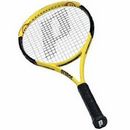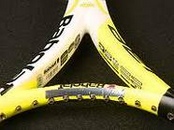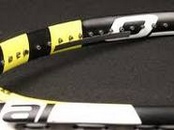Tungsten alloy racket weight



Tungsten alloy is right material for tennis rackets or the like to change the swing force and impact center known as the "sweet spot" on a tennis racket and more particularly relates to a snap-on weight that can be easily attached or removed.
All players have different swings and control of the racket although the swing fundamentals are the same. The intent is to make as square an impact with the ball as possible with the ball impacting as close as possible to the center of the tennis racket head known as the "sweet spot". But, size, weight, height, strength and other physical factors cause different players to alter the fundamental swing slightly causing "miss-hits" which in turn cause errors in the flight of the ball. A miss-hit, such as contacting the ball near the frame of the racket, will cause the ball to go in the direction different than where it is intended when the player swings.
The above problems can be caused not by a defect in the racket which certainly can contribute to the problem but any minor defect in the players swing. Thus even though the players swing appears to be fundamentally sound even a slightly off line swing, due to for example a weakness in a wrist, forearm, legs or whatever can cause a miss-hit.
It has been found that a player who has a swing that is close to fundamentally sound can improve their swing by slightly changing the balance of the racket head. Greater Weight on certain areas of the racket head can increase the force at which the player can hit the ball. Thus, even the best players can benefit from variations or increases of the weight of the tennis racket head.
When a tennis player strikes the ball he seeks to achieve as much control as possible with the greatest force applied to the ball. This occurs when the ball is struck at a position on the strings known as the "sweet spot" which is the central area of the strings. Also, a player attempts to hit the ball squarely with the racket head normal to the direction of flight of the ball. No two players have identical swings and therefore two different players may swing slightly different with the same racket. Further, since the tennis racket weight and overall structure is fixed after its made, the only way to achieve a different arrangement is to obtain a racket having a different weight or weight distribution. It would, however, be advantageous if weights could be easily added at selected points of the racket that would improve a players overall swing. Selected weighting could be used to not only increase the head weight for a more powerful serve but also to correct for imbalances in a players swing.
A small weight or weights added around the perimeter of the frame, forming the tennis racket head, can result in a swing that is normally slightly off the impact center, being now "on" improving accuracy and power which increases the speed and control of the ball. One such method of adding weight is by tape on the inside surface of the frame. However a disadvantage of this method is that it must be done when re-stringing the racket and the weight cannot be repositioned without removing and replacing the strings.
It is, therefore, one object of the present product to provide a snap-on weight for tennis rackets that allows a player to vary the weight distribution of a tennis racket. The position of the weight can be changed at will.
The purpose of the present product is to provide a snap-on weight for a tennis racket, or the like that allow a player to easily vary the amount and distribution of weight of the tennis racket head. The present product provides weights in the form of snap-on weighted clips that conveniently attach to the strings or frame of the racket head at selected positions around the racket.
A snap-on weight according to the product has a weight holder having a crown with slots at either end of an oblong portion terminating in bores that are approximately equal to the diameter to of strings of most tennis rackets. The length of the crown is slightly longer that the space between adjacent strings. The weight holder has short centrally located sleeve providing a cup or socket for receiving a weight such a lead pellet. The weights can be small lead pellets that are pushed into the socket and firmly held in place by nibs on the weight or by closing the pocket with a covering portion. The lead pellets can be provided in varying weights to allow the amount of weight added to a particular portion of the tennis racket to be varied.
The weighted holder is attached to the tennis racket by fitting an adjacent string into the slots on either side of the crown until the strings engage the bores and are locked on the tennis racket string. The weight can then be slid down on the strings until the small sleeve having the weighted socket is firmly abutting the inside surface of the frame forming the tennis racket head. The weight holder is made of a soft resilient synthetic or rubber like material. The amount of weight added to a tennis racket head can be varied by adding the weighted holder at various positions around the periphery of the frame securely attached to the tennis strings.
Related Links
Tungsten Alloy Rod
Tungsten Alloy Sheets
Material Safety Data Sheet of Tungsten Alloy
Material Safety Data Sheet of Tungsten Alloy (PDF)
Catalog of Tungsten Alloy Products (PDF)
















 sales@chinatungsten.com
sales@chinatungsten.com